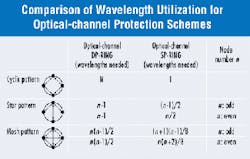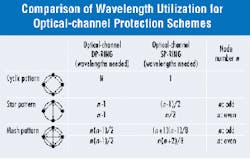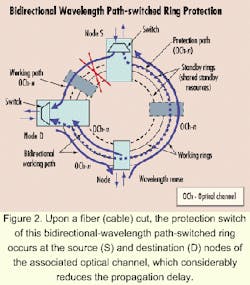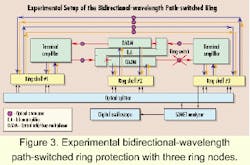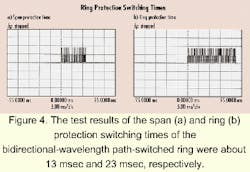New optical-channel shared protection-ring architecture
MILORAD CVIJETIC, NEC America, SHINYA NAKAMURA, NEC Corp., BORIS FAER, Sprint Communications
Wavelength-division multiplexing (WDM) equip ment in long-haul networks is designed to increase the transmission bandwidth of existing fiber, but current systems do not yet perform traffic protection or restoration. As such, Synchronous Optical Network/Synchron ous Digital Hierarchy (SONET/SDH) add/drop multiplexers (ADMs) have been required in transport networks to provide network survivability. A transition from traditional SONET/ SDH-based networks toward WDM-based optical transport networks (OTNs), with transport, multiplexing, routing, supervision, and survivability supported at the optical layer, is in progress.The survivability and scalability of ring architectures have made this topology the dominant architecture in broadband SONET/SDH networks today. The same attributes will make rings very attractive for OTNs. The speed at which the OTN recovers from misrouted, failed, or severely degraded conditions is critical. The recovery time should be on the order of tens of milliseconds. Rapid recovery time has been recognized by the T1X1.5 standard committee in the United States and the International Telecommunication Union-Telecommunication (ITU-T) standard committee; both groups have begun to work on defining types of ring architectures and subsequently specifying equipment functionality based on these architectures.1,2
The following network objectives should be considered when selecting self-healing ring architectures:
Optical rings, which provide protection at the optical-channel level, can generally be divided into two categories: dedicated and shared protection rings. Dedicated protection rings may use 1+1 or 1:1 protection in which the working traffic and protection traffic at the transmit end of a subnetwork connection are transmitted in two separate ways. In the case of 1+1 dedicated protection, the transmit end is permanently bridged, and the traffic will be transmitted on both the working and protection-subnetwork connections (see Figure 1a). At the receive end of the subnetwork connection, a protection switch is effected by selecting one of the signals based on purely local information. No APS protocol is re quired for this protection scheme if it is single-ended. In the case of dual-ended protection switching, 1:1 protection switching, or carriage of extra traffic in the protection trail, an APS protocol is required to coordinate between the local and remote switch and bridge operations.
Although dedicated protection is generally simpler than shared protection, the latter allows for more efficient capacity utilization for more distributed traffic patterns. While working at the optical-channel layer rather than at the OMS layer, the protection channel is shared among working channels (see Figure 1b).The Table shows the necessary number of wavelengths for several demand patterns for the architectures depicted in Figure 1. The number of wavelengths needed for the optical-channel dedicated protection ring (DP-RING) in a star-topology demand pattern is approximately equivalent to the optical-channel SP-RING, which means that both architectures are suitable for access-network applications. On the other hand, the necessary number of wavelengths for a 2-fiber optical-channel SP-RING of full-mesh demand pattern, which typically appears in a long-distance network, is about double that of the 2-fiber optical-channel DP-RING. The optical channel SP-RING, therefore, may be suitable for both long-distance network and metropolitan network applications.
A bidirectional-wavelength path-switch ed ring (BPSR) was developed to provide shared optical-channel-layer protection in the OTN. The protection architecture of the ring is illustrated in Figure 2. Upon a fiber (cable) cut, the protection switching of the BPSR occurs at the source and destination nodes of the associated optical channel, which considerably reduces the propagation delay. That is the main difference between this architecture and the optical bidirectional line-switched ring (BLSR) architecture, where the protection switching is performed at the two adjacent ring nodes connected to the disconnected fiber (cable), and some looping back occurs.
BPSR protection has been demonstrated in the lab with three ring nodes (see Figure 3). Each ring shelf has two types of interface cards. One is the long-reach interface card, which sends or receives signals to and from other ring nodes. The other interface card is the tributary card, which has a short-reach interface with client equipment.OC-48c (2.5-Gbit/ sec) testing signals from a SONET analyzer were sent to each ring node using an optical splitter. An optical switch was inserted at a location between ring shelf number 2 and the optical add/drop multiplexer (OADM) to emulate the fiber cut and span protection process. A second optical switch was inserted between the transmitter/receiver amplifier (TRM AMP) of ring node 3 and the OADM of node 2 to emulate a fiber cut and the ring protection process. The test results of the span and the ring protection-switching times were around 13 msec and 23 msec, respectively (see Figure 4).
The bit-error rate versus receiving power of the long-reach receiver (line side) and the jitter transfer (from the tributary side to the line side) were measured. Long-term error-free operation was demonstrated and jitter compliance with the Bellcore standard3 was shown.In addition, optical-layer protection of OC-48c traffic from either an Asynchron ous Transfer Mode (ATM) switch or a high-speed Internet protocol (IP) router was demonstrated. In the lab experiment, the ATM OC-48c traffic was configured in 1+1 tributary protection mode. OC-48c from the high-speed IP router was used for simulating low-priority, part-time traffic. Under normal operating conditions, the ATM traffic would be carried through the working path on the wavelength division-multiplexing (WDM) ring, and the part-time IP traffic would be carried on the protection path.
In this experiment, each WDM ring node had three tributary interface cards. A pair of interface cards (the W- and P-cards) served as 1+1 protection; these cards were connected to the working and protection cards of the ATM switch. The third interface card (the L-card) provided an interface for low-priority part-time traffic, it was connected to the high-speed IP router. In principle, when a fiber cut or network failure occurs, the WDM ring would perform an optical-layer span (or ring) protection switch. High-priority ATM traffic is switched to the protection path, while the low-priority IP traffic is dropped.
Tributary protection was tested by inserting an optical switch between the working tributary cards of WDM ring node 1 and the ATM switch to emulate a fiber cut. When the fiber between the tributary working card of WDM ring node 1 and the working card of the ATM switch 1 fails, WDM ring node 1 will detect loss of signal and switch traffic from the tributary working card to the protection card. In this case, there is no impact to the low-priority IP traffic. Since 1+1 unidirectional APS protection does not need protection signal protocol, the tributary APS protection time was very fast (8 msec).
Network protection was examined by inserting optical switches between WDM ring node 1 and WDM ring node 2, to emulate a fiber cut. When the working fiber between WDM ring nodes 1 and 2 is cut, a loss-of-signal alarm is detected by WDM ring node 2. WDM ring node 2 then performs an optical-layer switch for span protection; and WDM ring node 1 performs bridging after it receives SONET-like K1 and K2 commands. In this case, the ATM traffic was restored by the span protection within 13 msec, while low-priority IP traffic was dropped from the protection path.
Another scenario is optical-layer ring protection by the WDM ring in the event of a fiber cable cut. After detecting a cable cut, WDM ring node 2 sends a switching request to node 1 through a diverse route across node 3. Upon completion of the signaling process, WDM ring node 1 performs a ring bridge, and node 2 performs a ring switch for ring protection. The WDM ring protection time by physical layer test was 23.9 msec. The same protection time was measured from the ATM layer (33,827 cells were lost and the cell rate was 1,412,554 cells/sec).
An optical-channel SP-RING using BPSR protection was proposed and demonstrated. Fast protection switching was demonstrated in real traffic conditions. The ring demonstrated higher wavelength utilization efficiency, compared with other methods; it also displayed the advantage of less propagation delay.
Milorad Cvijetic, Ph.D., is optical-networking director at NEC America (Herndon, VA); Shinya Nakamura is product-development manager at NEC Corp. (Tokyo); and Boris Faer is senior applied R&D engineer at Sprint's Advanced Technology Labs (Burlingame, CA).
- U.S. proposal to ITU-T, "Proposed Framework for Optical Channel Architectures" (see ANSI T1X1.5/99-207R1).
- ITU-T Rec. 872.
- Bellcore Generic Requirement 253-CORE, "Synchronous Optical Network (SONET) Transport Systems: Common Generic Criteria," Issue 2, Revision 2, January 1999.
